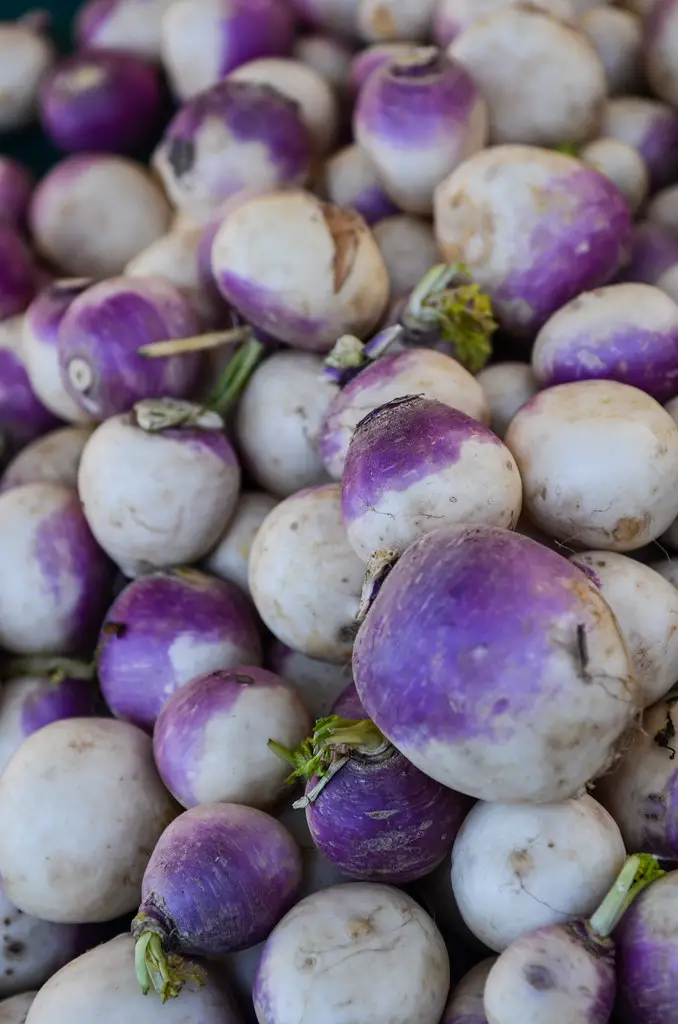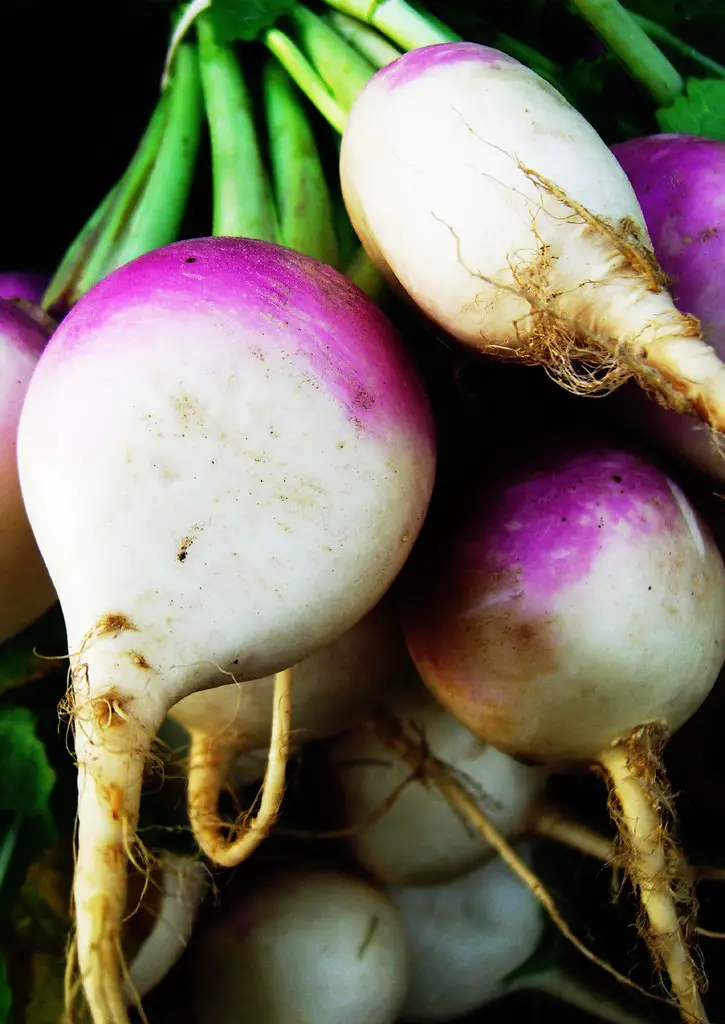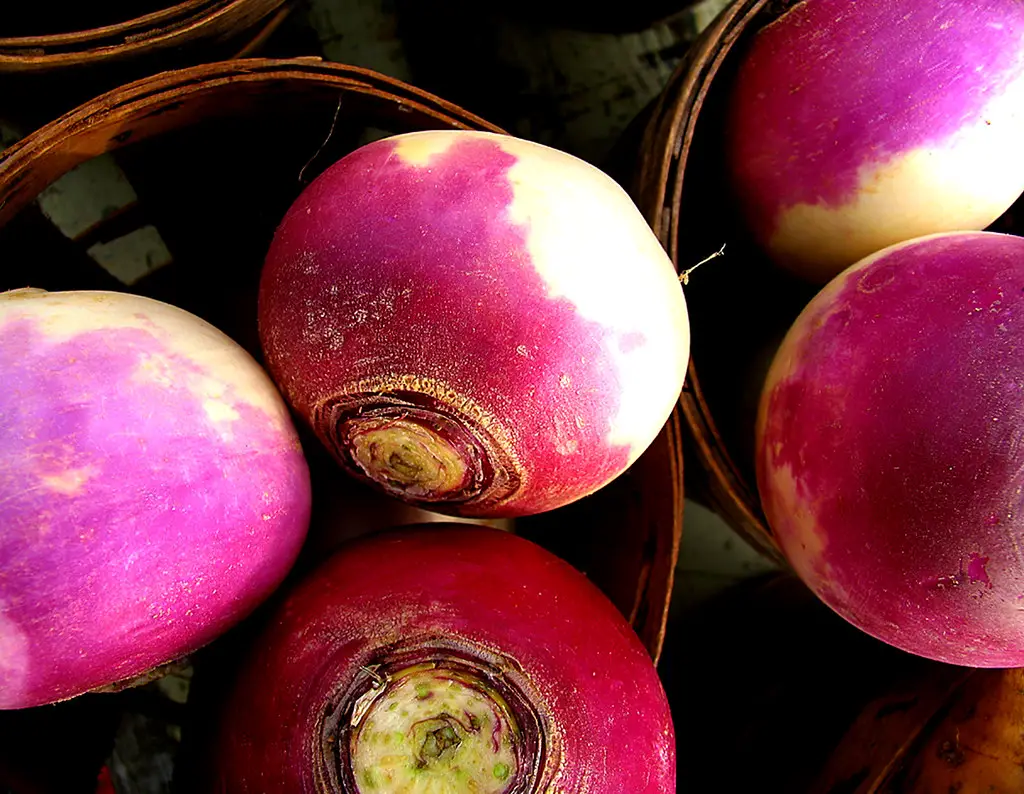How Long Does It Take For Turnip Seeds To Germinate? How Does Temperature Effect It? Turnips are a popular alternative vegetable to potatoes in the wintertime when supplies are running low. However, if you are planning to grow your own turnip at home one of the most common questions asked is how long do turnips take to germinate?
Turnips are an extremely fast germinator and will appear in less than 5 days when the temperatures are above 50°F (10°C) according to a study published by the University of California. However, below 50°F (10°C) the seeds will not germinate.
| Days To Germinate | Temperature (°F) | Temperature (°C) |
| – | 32 | 0 |
| – | 41 | 5 |
| 5.2 | 50 | 10 |
| 3.0 | 59 | 15 |
| 1.9 | 68 | 20 |
| 1.4 | 77 | 25 |
| 1.1 | 86 | 30 |
| 1.2 | 95 | 35 |
| 2.5 | 104 | 40 |
Turnips are a plant that is most commonly grown in the cooler months of the year because if can tolerate extreme temperatures. However, as the table shows above, despite the preference for cooler temperatures turnips still require a reasonable temperature to grow. This means that in most cases turnips are sown in the late summer or early autumn.
The reason for this is because it allows the turnips to develop in size before the weather gets too cool. At which point the growth will start to slow down and in some cases all but stop. This is advantageous in terms of creating a continuous harvest for your garden because you can grow the turnips to a reasonable size and then allow them to sit in the garden until you need them.
Turnips can withstand temperatures as low as 10°F (-12°C) which will result in the leaves burning but the plants surviving. Destruction of the foliage of these types of plants typically occurs around 26 to 28°F (-2 to 3°C). As such if you have extreme weather it is advisable to provide some protection from the middle of autumn onwards.

Copy text
How To Grow Turnips
As mentioned above the most common way to grow turnips is to plant them in late summer for a late fall harvest. However, it is possible also to grow them in the early part of the spring, however, this is far less common because there are a large number of alternative vegetables that can be grown at that point of time which people tend to favor over turnips.
When planting turnips they can be sown directly into the garden, however, in late summer the garden is often packed with summer vegetables which means that there is often a struggle for space. As a result of this, we generally recommend that you plant turnips into a seed tray.
To do this start by filling the seed tray with a good quality seed raising mix and then firm it down to create solid plugs. This is important as it will make it a lot easier to transplant the plant later on and reduce root disturbance during this process.
When planting seedlings we recommend sowing 4 to 6 seedlings per cell which is generally higher than what most gardeners will recommend. However, the reason for this is that turnips are one of those plants that can be multi-sown which has distinct advantages over planting individual seedlings.
The main advantage is that the transplanting of seedlings is much faster, as is the maintenance of the beds where the turnips are grown. The reason for this is because each time a planting hole is made 4 to 6 seedlings are transplanted rather than just one making it much faster.
The second benefit is that because you are getting more seedlings per planting they can be planted a little bit further apart which is beneficial because it allows you to use a dutch hoe to weed rather than hand weeding around the plants which is much faster.

Copy text
If you keep the clumps of seedlings to 4 to 5 it will not substantially affect the size of the turnips. However, if you go any higher in the number of seedlings it will affect the size of the turnips produced.
Once the seeds are planted it is important to keep the soil moist to maintain healthy young seedlings. As mentioned above the germination of these plants will be relatively fast however despite this speed of growth the seedlings will still need to spend around 6 weeks in the seed tray before they can be planted out into the garden.
Transplanting Turnips
When planting out the clumps of turnips they should be spaced approximately 8 to 10 inches apart in a rich moist and free-drained soil that has plenty of nutrients. If you are unsure about the quality of the soil it is advisable to add a bag of compost before planting.
As the young seedlings can be susceptible to attack from slugs and snails it is also advisable to put snail bait around them on the same day that you put them into the ground. The location selected should get at least 6 to 8 hours of sun per day to maximize the speed of growth.
As the seedlings can sometimes be put into the ground when the weather is still relatively warm it is also advisable to apply a thick layer of mulch to help retain the moisture. It also helps to keep the beds weed-free to avoid competition.

Copy text
Harvesting Turnips
Turnips can generally be harvested at any stage however we recommend waiting until they reach approximately the size of a golf ball. If you have planted in clumps it is important to twist out the largest turnips as you need them to avoid disturbing the remaining roots in the clump.
Additionally, if you believe that you are a little late in planting the turnips you can also place a row cover over the plants to keep them a little bit warmer later in the season to try and get a little bit of extra growth to ensure that they get to a reasonable sized before extreme cold sets in.
As mentioned above turnips can be left in the ground until you are ready to harvest them or they can be brought in and stored in a cool root cellar where they will last for a couple of months during the winter period. They generally do not store as well as swedes or potatoes so it is advisable to eat them before you eat other root crops.
I hope you found this article useful and have great success growing turnips at home, if you have any additional comments or questions please leave them in the section below.
Relevant Articles
Are Swede (Rutabaga) and Turnip the Same Thing?
How Long Does It Take Spinach Seeds To Germinate? How Does Temperature Effect It?
How Long Does It Take Lettuce Seeds To Germinate? How Does Temperature Effect It?
How Long Does It Take Pepper Seeds To Germinate? How Does Temperature Effect It?
Are Radishes and Turnips The Same? (The Differences And Similarities)
